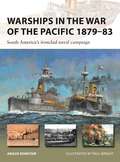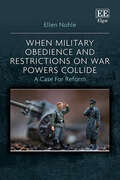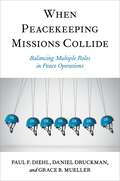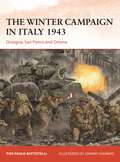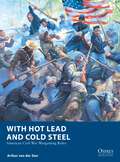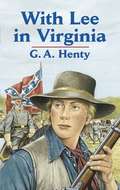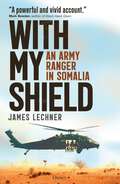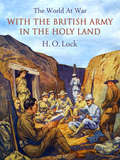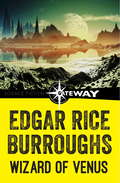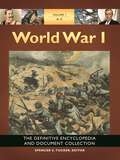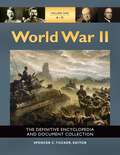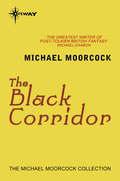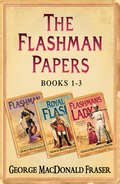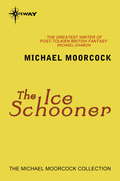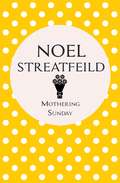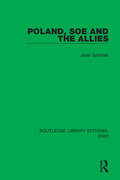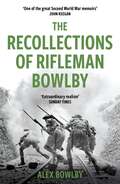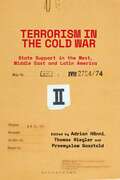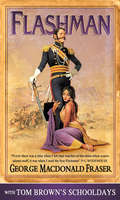- Table View
- List View
Warship 2024
by John JordanThe 2024 edition of Warship, the celebrated annual publication featuring original research on the history, development, and service of the world's warships. For over 45 years, Warship has been the leading annual resource on the design, development, and deployment of the world's combat ships. Featuring a broad range of articles from a select panel of distinguished international contributors, this latest volume combines original research, new book reviews, warship notes, an image gallery, and much more, maintaining the impressive standards of scholarship and research with which Warship has become synonymous. Detailed and accurate information is the hallmark of all the articles, which are fully supported by plans, data tables, and stunning photographs. This year's Warship includes features on Imperial Japan's Matsu and Tachibana destroyer classes, the Italian CRDA midget submarines, France's 1960s missile frigates Suffren and Duquesne, and Germany's sailing raider of World War I, Seeadler.
Warships in the War of the Pacific 1879–83: South America's ironclad naval campaign (New Vanguard #328)
by Angus KonstamSuperbly illustrated with original artwork throughout, this book explores the ironclad warships that fought the little-known battles of South America's War of the Pacific. In the late 19th century, a war erupted between Chile and Peru, the catalyst for which was control of guano-rich Chincha islands. Given the geography of the two countries, with a narrow, arid land border and long exposed coastlines, it was inevitable that the War of the Pacific would predominantly be a naval war. It was a unique episode of military history, fought by two newly emergent South American states, using the latest technology – ironclad, steam-powered warships – and involving more naval battles than in the American Civil War, including a blockade, the capture of key warships, and bombardments of ports. Chile's navy was larger and more modern, while Peru's trump card was the small but powerful ironclad Huáscar. In this book, naval expert Angus Konstam offers readers an essential guide to this little-known naval war, illustrated with detailed profiles of the key ironclads, spectacular original artwork of the battles and a cutaway of Huáscar. He briefly covers the strategies of the warring powers as well as exploring all the key points of the naval campaign and the details of the warships involved, as a handful of ironclads fought for naval supremacy in South America.
When Military Obedience and Restrictions on War Powers Collide: A Case For Reform
by Ellen NohleThis provocative book explores the precarious conflict between the legal restrictions on governments’ power to take military action and the legal liability of soldiers to execute military orders. Adopting a multidisciplinary approach, this insightful book challenges the current distribution of trust between military decision-makers and agents, and how the law of military obedience effectively extends the powers of officials beyond the limits of international and constitutional law. In order to mitigate the potentially devastating consequences of the abuse of military authority, the book proposes an adjustment of the legal and social role of soldiers, enabling them to disobey transgressive orders. By placing soldiers at the centre of reform, it affirms the human dignity and moral agency of servicemembers, granting them the tools they need to protect themselves against the moral injuries they could potentially suffer as a result of obeying unlawful commands. Students and scholars of constitutional law, human rights, humanitarian law, military law and public international law will find this book to be an invaluable resource. It will also be beneficial for policymakers, think-tanks and other agents of change who are concerned about the abuse of military authority.
When Peacekeeping Missions Collide: Balancing Multiple Roles in Peace Operations
by Paul F. Diehl Daniel Druckman Grace B. MuellerThe contemporary world is beset with a wide variety of conflicts, all of which have features without historical precedent. While most accounts of peacekeeping focus on attempts to limit violent conflict, this traditional view hardly captures the variety of challenges that today's peacekeepers face. Peacekeepers are now thrust into the unconventional roles of monitoring elections, facilitating transitions to the rule of law, distributing humanitarian aid, and resolving conflicts in civil societies that are undergoing transformation. This is the context for understanding the activities of modern-day peacekeepers. In When Peacekeeping Missions Collide, Paul F. Diehl, Daniel Druckman, and Grace B. Mueller provide an original and comprehensive assessment on how different peacekeeping missions intersect with one another in contemporary conflicts. They begin by documenting the patterns of peacekeeping missions in 70 UN operations, noting the dramatic increase in number and diversity of operations since the end of the Cold War as well as the shift to conflicts with a substantial internal conflict component. They then turn to the overarching question of the book: how do individual peacekeeping missions impact the outcomes of other missions within the same operations? To answer this, the authors have developed a novel dataset of UN peace operations from 1946-2016 to assess mission compatibility. Moreover, the authors utilize five detailed case studies of UN peacekeeping operations featuring mission interdependence and then measure the results against their theoretical expectations. Ultimately, the model they have developed for analyzing the effectiveness of the far more complex peace operations of today--relative to the simpler operations of the past--is essential reading for scholars of peacekeeping and conflict management.
The Winter Campaign in Italy 1943: Orsogna, San Pietro and Ortona (Campaign #395)
by Pier Paolo BattistelliA gripping tale of three crucial battles fought at the end of 1943 as Allied forces approached the Gustav Line in Italy.After repulsing the German counter-attack at Salerno in September 1943, the US Fifth Army and British Eighth Army advanced up the Italian Peninsula. By October, the Allied armies had reached the Volturno Line, forcing a critical decision in German strategy: a prolonged defence would be conducted in southern Italy, contesting the Allied advance using the complex terrain features. By mid-November, the two Allied armies were approaching the German defensive lines along the Garigliano and the Sangro rivers. Here, US 5th Army would attack through the Mignano gap towards San Pietro Infine, while British Eighth Army would seize Ortona on the Adriatic coast and Orsogna. A brutal struggle ensued, with the German defenders attempting to hold their positions. The fighting at Ortona in particular (labelled a 'mini Stalingrad') would be particularly grueling for the Canadian forces involved. This fascinating work focuses on several little-known battles fought in Italy following the German withdrawal from the Salerno bridgehead and from Taranto. Maps and diagrams present an easy to follow overview of the multiple operations of this complex campaign. The forces of the opposing sides (including American, German, Canadian, New Zealand and British troops), and the three decisive battles fought in late 1943, are brought vividly to life in period photos and superb battlescene artworks.
With Hot Lead and Cold Steel: American Civil War Wargaming Rules (Osprey Wargames #32)
by Arthur van SterA set of wargaming rules for fighting large battles set during the American Civil War.From the First Bull Run to Appomattox Court House, enter one of the defining conflicts of American history. With shot, shell, and sabre, guide the armies of the Blue and the Grey through this first modern war to determine the fate of a nation.With Hot Lead and Cold Steel is a large-scale, mass-battle wargame for recreating the American Civil War. Designed to handle brigade and divisional level engagements while providing a balance between ease of play and period detail, With Hot Lead and Cold Steel is ideal for new gamers and wargaming veterans alike. It contains everything players need to raise armies and craft scenarios, whether based upon historical campaigns and orders of battle or those of their own devising.
With Lee in Virginia: A Story Of The American Civil War (The Land of Oz)
by G. A. HentyIn this spirited tale of adventure, Vincent Wingfield, who is not yet sixteen, returns home to Virginia after four years of school in England to find conditions in America greatly unsettled. When war breaks out in 1861, Vincent staunchly supports the rights of slaves but joins Lee's cavalry to fight for the Confederacy.Henty's gripping story, written several decades after the war, weaves the spirited teenager's adventures with real-life events, while providing an acute glimpse of the conflict from a Southern perspective.A prolific 19th-century author, G. A. Henty celebrates family, honor, loyalty, bravery, and determination in the face of adversity. Set against the backdrop of an exciting historical era, this story, recently rediscovered by young readers, will excite the imaginations of today's youngsters as much as it thrilled readers when first published.
With My Shield: An Army Ranger in Somalia
by James LechnerThis is the inside story of an Army Ranger, surrounded and outnumbered, fighting a desperate action on the ground during the Black Hawk Down raid in Somalia in 1993. In 1993 Lieutenant James Lechner, a member of the 3rd Ranger Battalion, was selected for a top secret special operations task force being sent to Mogadishu, Somalia, to capture the insurgent leader Mohamed Farah Aideed. In early October, after weeks on the ground and conducting a number of raids in the city, the Task Force is called upon to conduct a daring daylight mission into the heart of Aideed's territory. During the raid, following the initial dangerous fast rope insertion and subsequent capture of a group of Aideed's lieutenants, one of the Task Force Black Hawk helicopters is shot down and Lechner and his comrades are soon caught up in the fiercest combat involving US forces since the Vietnam War. In the middle of the hostile city, deep in the enemy's stronghold, the small group of Rangers and special operators now find themselves fighting not only to rescue the downed helicopter's crewmen, but also to save their own lives. This first-hand account tells the story of how these elite warriors were able to stand together and prevail against incredible odds. It gives the reader the perspective of an Army Ranger fighting on the ground, combined with professional military analysis, in a groundbreaking book that tells the complete story with never-before-revealed details.
With the British Army in The Holy Land (The World At War)
by H. O. LockThe Holy Land has been the scene of war since the dawn of History. Long before Belgium became the cock-pit of Europe, Palestine was the cock-pit of the known world. Here, on the high road between Asia and Africa, were fought the great wars of Egyptians and Assyrians, Israelites and Canaanites, Greeks and Romans, Saracens and Crusaders. With these few square miles are associated the names of the world's greatest soldiers no less than that of the Prince of Peace. None can fail to be interested in the latest campaign in this Land of Armageddon. (Goodreads)
The Wizard of Venus
by Edgar Rice BurroughsThe fifth and final adventure of Carson Napier among the exotic peoples and beasts of Amtor is Burroughs' THE WIZARD OF VENUS. Sequel to his fabulous four Venus novels, it is an adventure not to be missed as Napier encounters a new kind of science and a new master of alien deviltry.
World War I [5 volumes]: The Definitive Encyclopedia and Document Collection [5 volumes]
Offering exhaustive coverage, detailed analyses, and the latest historical interpretations of events, this expansive, five-volume encyclopedia is the most comprehensive and detailed reference source on the First World War available today.One hundred years after the beginning of World War I in 1914, this conflict still stands as perhaps the most important event of the 20th century. World War I toppled all of the existing empires at the time, transformed the Middle East, and vaulted the United States to becoming the world's leading economic power. Its effects were profound and lasting—and included outcomes that led to World War II. This multivolume encyclopedia provides a wide-ranging examination of World War I that covers all of the important battles; key individuals, both civilian and military; weapons and technologies; and diplomatic, social, political, cultural, military, and economic developments.Suitable as a reference tool for high school and undergraduate students as well as faculty members and graduate-level researchers, World War I: The Definitive Encyclopedia and Document Collection offers accessible, in-depth information and up-to-date analyses in a format that lends itself to quick and easy use. The set comprises alphabetically arranged, cross-referenced entries accompanied by further reading selections as well as a comprehensive bibliography. A fifth volume provides chronologically arranged documents and an A–Z index.
World War II [5 volumes]: The Definitive Encyclopedia and Document Collection [5 volumes]
With more than 1,700 cross-referenced entries covering every aspect of World War II, the events and developments of the era, and myriad related subjects as well as a documents volume, this is the most comprehensive reference work available on the war.This encyclopedia represents a single source of authoritative information on World War II that provides accessible coverage of the causes, course, and consequences of the war. Its introductory overview essays and cross-referenced A–Z entries explain how various sources of friction culminated in a second worldwide conflict, document the events of the war and why individual battles were won and lost, and identify numerous ways the war has permanently changed the world. The coverage addresses the individuals, campaigns, battles, key weapons systems, strategic decisions, and technological developments of the conflict, as well as the diplomatic, economic, and cultural aspects of World War II.The five-volume set provides comprehensive information that gives readers insight into the reasons for the war's direction and outcome. Readers will understand the motivations behind Japan's decision to attack the United States, appreciate how the concentration of German military resources on the Eastern Front affected the war's outcome, understand the major strategic decisions of the war and the factors behind them, grasp how the Second Sino-Japanese War contributed to the start of World War II, and see the direct impact of new military technology on the outcomes of the battles during the conflict. The lengthy documents volume represents a valuable repository of additional information for student research.
The Black Corridor
by Michael MoorcockThe world is sick. The Forces of Chaos have energised the planet. Leaders, führers, duces, prophets, visionaries, gurus, and politicians are all at each others' throats. And Chaos leers over the broken body of Order.So Ryan freezes his family into suspended animation and sets off for the planet Munich 15040, five years distant. There he will re-establish Order in a New World - and create a happier, healthier, saner and more decent society with the ones he loves.But they are suspended. And they cannot talk. And he is alone in space. And he has been travelling for three years. And he will still be travelling two years hence, and he cannot see his destination, and he is ALONE and LOST and CRACKING UP...
Flashman Papers 3-Book Collection 1: Flashman; Royal Flash; Flashman's Lady
by George MacDonald FraserThe first three books in George MacDonald Fraser’s uproarious bestselling Flashman series, now available in one ebook for the first time.
The Geronimo Campaign
by Odie B. FaulkThe surrender of the great Apache leader Geronimo to U.S Army Lieutenant Charles B. Gatewood in August of 1886 brought to an end a struggle that had begun in the early years of the century, and had figured prominently in the western campaign of the Civil War. The words addressed by Gatewood to Geronimo as they met along the banks of Mexico's Bavispe River echoed those spoken in many such a meeting between victorious American commander and vanquished Native American. "Accept these terms or fight it out to the bitter end," said Gatewood. The terms were forced relocation to Florida and the ceding of the ancestral homeland of the Apaches to white settlers; the bitter end was, quite simply, annihilation. In The Geronimo Campaign, Odie B. Faulk, a leading historian of the American Southwest, offers a lively and often chilling account of the war that raged over the deserts and mountains of Arizona, New Mexico, and northern Mexico in the mid 1880's, and traces its legacy well past the ultimatum delivered to Geronimo on August 25, 1886. Faulk is especially concerned with the campaign's wider historical setting and significance, and with the sad record of betrayal of the Native American by the U.S. Government. In a very real sense, it is the stuff of Greek tragedy. Here among the mesas of the Southwest was inevitable conflict and inevitable defeat, with both sides losing and yet surviving their loss. The Apaches were forced to endure years of captivity and humiliation, and--like the Sioux, Comanche, and Nez Percé before them--the obliteration of their traditional way of life. The Army, seemingly the winner, was torn by conflicting claims of glory by its hubristic leaders. And Americans lost much that Apache culture might have contributed to their country, as well as more than a measure of American self-respect. Few emerge from Faulk's riveting account with their dignity and stature intact: only the titanic figure of Geronimo, and to a lesser extent the two men he knew and trusted among his opponents, Gatewood and General George Crook, retain a semblance of honor. Faulk shows that neither side wanted war, that both sides believed in the righteousness of their cause, and that the real instigators of the conflict were rapacious American settlers--the "Tucson Ring" of merchants--who sold grain, hay, and other provisions to the troops as well as to those living on the Indian reservations. Faulk's realistic and colorful narrative highlights many of the campaign's ironies as well as its dangers and vicissitudes. In addition, it vividly recreates life in an Army command post on the western frontier, offers an exceptionally clear and sympathetic life history of Geronimo, and sheds new light on the conflict through many hitherto unknown documents originally collected by Gatewood's son. Also included is a brief history of the Apache people, a full bibliography and notes, and many vintage photographs which lend a rare immediacy to this tragic story. The Geronimo Campaign ends with the great chief hundreds of miles away from his ancestral home, Crook relieved of his command, and Gatewood largely forgotten in the honors and awards bestowed by the Army in recognition of Geronimo's capitulation. A true American saga, this is a book for anyone who wishes to understand the roots of, and the reasons for, the tragic Indian Wars of the nineteenth century, a tragedy whose repercussions are still felt today.
The Ice Schooner
by Michael MoorcockThe world lay frozen under a thousand feet of ice. Only in the Eight Cities of the Matto Grosso did men still live, hunting the wary ice whales for meat and oil, and following the creed of the Ice Mother which foretold the end of all life in ultimate cold.But legend told of a city far to the north - fabled New York - whose towers rose above the ice, whose crypts held the forgotten lore that might bring warmth to Earth once again. In the best ice ship in the Eight Cities, Konrad Arflane embarked on the impossible voyable to New York - an odyssey of incredible peril and adventure with a shattering discovery at the journey's end...
Katalin Street: WINNER of the 2018 PEN Translation Prize
by Magda SzabóWINNER OF THE 2018 PEN TRANSLATION PRIZE - BY THE AUTHOR OF THE DOOR, ONE OF THE NEW YORK TIMES BOOK REVIEW'S TEN BEST BOOKS OF 2015"Extraordinary" New York Times"Quite unforgettable" Daily Telegraph"Unusual, piercing . . . oddly percipient" Irish Times"A gorgeous elegy" Publishers Weekly"A brightly shining star in the Szabo universe" World Literature TodayIn prewar Budapest three families live side by side on gracious Katalin Street, their lives closely intertwined. A game is played by the four children in which Bálint, the promising son of the Major, invariably chooses Irén Elekes, the headmaster's dutiful elder daughter, over her younger sister, the scatterbrained Blanka, and little Henriette Held, the daughter of the Jewish dentist.Their lives are torn apart in 1944 by the German occupation, which only the Elekes family survives intact. The postwar regime relocates them to a cramped Soviet-style apartment and they struggle to come to terms with social and political change, personal loss, and unstated feelings of guilt over the deportation of the Held parents and the death of little Henriette, who had been left in their protection. But the girl survives in a miasmal afterlife, and reappears at key moments as a mute witness to the inescapable power of past events.As in The Door and Iza's Ballad, Magda Szabó conducts a clear-eyed investigation into the ways in which we inflict suffering on those we love. Katalin Street, which won the 2007 Prix Cévennes for Best European novel, is a poignant, sombre, at times harrowing book, but beautifully conceived and truly unforgettable.Translated from the Hungarian by Len Rix
Montgomery the Field Marshal: A Critical Study of the Generalship of Field-Marshal the Viscount Montgomery of Alamein, K.G. and of the Campaign in North-West Europe, 1944/45 (Routledge Library Editions: WW2 #19)
by R.W. ThompsonThis book, first published in 1969, examines the achievement of Montgomery and the 21st Army Group in the campaign in Northwest Europe in 1944-45. The author observed the campaign first-hand, and has spent twenty years poring over war diaries and regimental papers to provide an in-depth analysis of Montgomery’s generalship, personality, complex relations with his American allies, and his own subordinates. Looking at Montgomery’s performance as a morale builder both for troops and civilians, this books also examines his difficulties with the diplomatic niceties of coalition warfare.
Montgomery the Field Marshal: A Critical Study of the Generalship of Field-Marshal the Viscount Montgomery of Alamein, K.G. and of the Campaign in North-West Europe, 1944/45 (Routledge Library Editions: WW2 #19)
by R.W. ThompsonThis book, first published in 1969, examines the achievement of Montgomery and the 21st Army Group in the campaign in Northwest Europe in 1944-45. The author observed the campaign first-hand, and has spent twenty years poring over war diaries and regimental papers to provide an in-depth analysis of Montgomery’s generalship, personality, complex relations with his American allies, and his own subordinates. Looking at Montgomery’s performance as a morale builder both for troops and civilians, this books also examines his difficulties with the diplomatic niceties of coalition warfare.
Mothering Sunday
by Noel StreatfeildSeventy-year-old widowed Anna Caldwell likes to be alone, happy to potter around her garden chatting to her friend Miss Poe. However, the bliss of Anna’s peaceful lifestyle causes her five children much dismay.Jane, the eldest and most organised, gathers her siblings together to visit Anna on Mothering Sunday. Henry the politician, Margaret the doctor and the youngest, Felicity, all agree to attend with their partners . . . but that leaves Tony, the shadow on the family’s respectable past.Carnegie Medal winning author Noel Streatfeild pieces together a startling image of the post-war British family in her novel Mothering Sunday.
Poland, SOE and the Allies (Routledge Library Editions: WW2 #24)
by Jozef GarlinskiThis book, first published in 1969, discusses objectively the tragic wartime position of Poland, having both the Nazis and Soviets as enemies – the war opened with the country being invaded by both. The book examines the work of the Polish underground army (Home Army) and its cooperation with SOE in providing intelligence of German movements – plans for attacking the Soviet Union, and experiments with V2 rockets. It also gives special attention to the Warsaw Rising and the political and military problems connected with it.
Poland, SOE and the Allies (Routledge Library Editions: WW2 #24)
by Jozef GarlinskiThis book, first published in 1969, discusses objectively the tragic wartime position of Poland, having both the Nazis and Soviets as enemies – the war opened with the country being invaded by both. The book examines the work of the Polish underground army (Home Army) and its cooperation with SOE in providing intelligence of German movements – plans for attacking the Soviet Union, and experiments with V2 rockets. It also gives special attention to the Warsaw Rising and the political and military problems connected with it.
The Recollections Of Rifleman Bowlby (W&N Military)
by Alex Bowlby'One of the great Second World War memoirs ... will be read as long as that war is remembered' John Keegan'Extraordinary realism' SUNDAY TIMES'A touch of the Somme and more than a hint of Wilfred Owen' TLSA classic of WWII, this is the vivid memoir of Private Bowlby, who came through the North Africa campaign only to have to battle in bitter fighting against a stubborn and skilled German defence in Italy. It is a truly authentic account of what it was like to fight your way through one of the most gruelling and dangerous campaigns of the Second World War, where so often the hunters became the hunted.A superb first-hand account of the the second world war.
Terrorism in the Cold War: State Support in the West, Middle East and Latin America
by Adrian Hänni Thomas Riegler Przemyslaw GasztoldAccounts of the relationships between states and terrorist organizations in the Cold War era have long been shaped by speculation, a lack of primary sources and even conspiracy theories. In the last few years, however, things have evolved rapidly. Using a wide range of case studies including the British State and Loyalist Paramilitaries in Northern Ireland, as well as the United States and Nicaragua, this book sheds new light on the relations between state and terrorist actors, allowing for a fresh and much more insightful assessment of the contacts, dealings, agreements and collusion with terrorist organizations undertaken by state actors on both sides of the Iron Curtain.This book presents the current state of research and provides an assessment of the nature, motives, effects, and major historical shifts of the relations between individual states and terrorist organizations. The articles collected demonstrate that these state-terrorism relationships were not only much more ambiguous than much of the older literature had suggested but are, in fact, crucial for the understanding of global political history in the Cold War era.
Tom Brown’s School Days and Flashman
by George MacDonald Fraser Thomas HughesThe first in George MacDonald Fraser’s uproarious Flashman series and the classic they pay homage to available together for the first time in ebook format.

